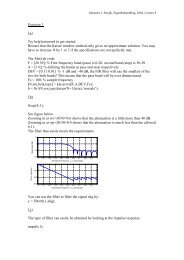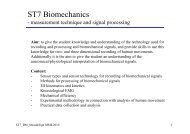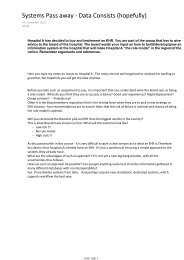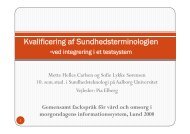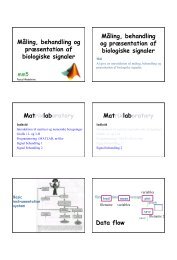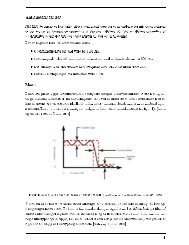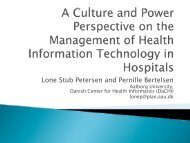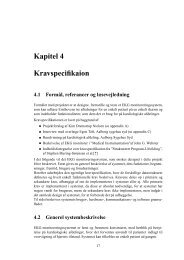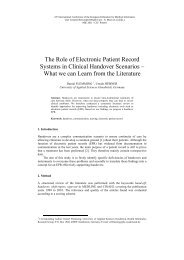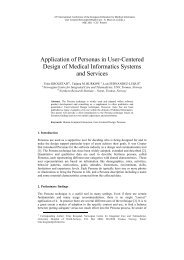Evaluation of telephone triage and advice services - Department of ...
Evaluation of telephone triage and advice services - Department of ...
Evaluation of telephone triage and advice services - Department of ...
You also want an ePaper? Increase the reach of your titles
YUMPU automatically turns print PDFs into web optimized ePapers that Google loves.
<strong>Evaluation</strong> <strong>of</strong> <strong>telephone</strong> <strong>triage</strong> <strong>and</strong> <strong>advice</strong> <strong>services</strong>:<br />
a systematic review on methods, metrics <strong>and</strong> results<br />
23 rd<br />
<strong>Evaluation</strong> <strong>of</strong><br />
<strong>telephone</strong> <strong>triage</strong> <strong>and</strong> <strong>advice</strong> <strong>services</strong>:<br />
a systematic review on methods, metrics <strong>and</strong> results<br />
Sara CARRASQUEIRO, MSc a) , Mónica OLIVEIRA, PhD b)<br />
<strong>and</strong> Pedro ENCARNAÇÃO, PhD a)<br />
a Catholic University <strong>of</strong> Portugal, Faculty <strong>of</strong> Engineering, Lisbon, Portugal<br />
b Instituto Superior Técnico, Technical University <strong>of</strong> Lisbon, Lisbon, Portugal<br />
Oral presentation at MIE 2011, Session 16<br />
August 30 th , Oslo, Norway<br />
International Conference <strong>of</strong> the European<br />
Federation for Medical Informatics<br />
Sara Carrasqueiro<br />
sara.carrasqueiro@fe.lisboa.ucp.pt<br />
1
Scope - TTAS<br />
Telephone <strong>triage</strong> <strong>and</strong> <strong>advice</strong> <strong>services</strong> (TTAS) are e-health <strong>services</strong> that<br />
combine the use <strong>of</strong> call centre technology<br />
with formal or informal clinical decision systems<br />
to evaluate patients’ acute health conditions<br />
<strong>and</strong> advise them or their caregivers to act accordingly<br />
helping to adequate the dem<strong>and</strong> for healthcare <strong>services</strong> to actual patient needs<br />
HEALTH<br />
PROBLEM<br />
DEMAND FOR<br />
UNSCHEDULED<br />
CARE<br />
CALL 911 / 112<br />
HOSPITAL EMERGENCY<br />
DEPARTMENT VISIT<br />
SAME DAY APPOINTMENT<br />
IN GENERAL PRACTICE<br />
SYMPTHOMS<br />
EVALUATION<br />
DO NOTHING / SELF-CARE /<br />
UNFORMAL CARE<br />
TELEPHONE TRIAGE AND ADVICE SERVICE<br />
CARE NEEDED<br />
DETERMINATION<br />
PATIENT<br />
ADVICE &<br />
REFERRAL<br />
<strong>Evaluation</strong> <strong>of</strong> <strong>telephone</strong> <strong>triage</strong> <strong>and</strong> <strong>advice</strong> <strong>services</strong>:<br />
a systematic review on methods, metrics <strong>and</strong> results<br />
PATIENT<br />
DECISION<br />
DEMAND FOR<br />
CARE AFTER<br />
TTAS<br />
CALL 911 / 112<br />
HOSPITAL EMERGENCY<br />
DEPARTMENT VISIT<br />
SAME DAY APPOINTMENT<br />
IN GENERAL PRACTICE<br />
DO NOTHING / SELF-CARE /<br />
UNFORMAL CARE<br />
Sara Carrasqueiro<br />
sara.carrasqueiro@fe.lisboa.ucp.pt<br />
2
Aims <strong>of</strong> the study<br />
• review <strong>and</strong> summarize evidence about TTAS’<br />
impact on healthcare systems<br />
• analyze<br />
– methods <strong>and</strong> metrics used<br />
– studies’ quality<br />
– results<br />
• define future research needs<br />
<strong>Evaluation</strong> <strong>of</strong> <strong>telephone</strong> <strong>triage</strong> <strong>and</strong> <strong>advice</strong> <strong>services</strong>:<br />
a systematic review on methods, metrics <strong>and</strong> results<br />
Sara Carrasqueiro<br />
sara.carrasqueiro@fe.lisboa.ucp.pt<br />
3
1. Terms selection<br />
from terminologies associated with TTAS;<br />
Terms mostly associated with specific<br />
medical problems’ <strong>advice</strong> or with follow-up<br />
or self support <strong>services</strong> were excluded:<br />
‘<strong>telephone</strong> counseling’, ‘counseling call<br />
centre’, ‘counseling line’, ‘consultation call<br />
centre’, ‘helpline’ <strong>and</strong> ‘hotline’<br />
2. Filters definition<br />
to retrieve:<br />
• evaluation studies<br />
• evaluations from the viewpoint <strong>of</strong> the<br />
healthcare system<br />
• papers published from 1995 to present<br />
3. Search in PubMed database<br />
4. Screening<br />
using title <strong>and</strong> abstract information<br />
to exclude papers outside the scope<br />
Methods<br />
<strong>Evaluation</strong> <strong>of</strong> <strong>telephone</strong> <strong>triage</strong> <strong>and</strong> <strong>advice</strong> <strong>services</strong>:<br />
a systematic review on methods, metrics <strong>and</strong> results<br />
Search Strategy<br />
1 (tele<strong>triage</strong> OR <strong>telephone</strong> <strong>triage</strong> OR<br />
<strong>telephone</strong> consultation OR NHS Direct OR<br />
<strong>telephone</strong> <strong>advice</strong> OR tele-<strong>advice</strong> OR<br />
health call centre OR (nurs* AND call centre)<br />
OR <strong>triage</strong> call centre OR<br />
(consul* AND call centre) OR<br />
(after-hours AND call centre) OR <strong>triage</strong> line OR<br />
Advice line OR (<strong>telephone</strong>-based AND <strong>triage</strong>)<br />
[Title/Abstract]<br />
2 (impact OR assess* OR effect* OR evaluat* OR<br />
econom*)[All Fields]<br />
3 #1 AND #2<br />
4 (hospital OR visit* OR pathway* OR emergency*<br />
OR referral OR utilization)[All Fields]<br />
5 #3 AND #4<br />
6 "1995"[PDAT] : "3000"[PDAT]) AND "0"[PDAT] :<br />
"3000"[PDAT]<br />
7 #5 AND #6<br />
Sara Carrasqueiro<br />
sara.carrasqueiro@fe.lisboa.ucp.pt<br />
4
Methods (Cont.)<br />
5. Full paper analysis, data collection <strong>and</strong> categorization<br />
Context<br />
• Country;<br />
• Organization model:<br />
st<strong>and</strong> alone, embedded<br />
in healthcare delivery<br />
units;<br />
Features<br />
• Availability: 24-hours,<br />
out-<strong>of</strong>-hours or in-hours;<br />
• Patients: pediatric, adult<br />
or all ages;<br />
• Pr<strong>of</strong>essionals: nurses,<br />
physicians, both, others;<br />
• Technologies: protocols,<br />
computerized, access to<br />
EMR;<br />
• Maturity: established<br />
over 3 years, 3 or less<br />
years <strong>of</strong> operation, pilot;<br />
a meta-analysis was considered inappropriate due to large heterogeneity in<br />
methods, metrics <strong>and</strong> context <strong>of</strong> TTAS studies<br />
6. Critical assessment <strong>of</strong> studies<br />
• modified version <strong>of</strong> “a check-list for assessing economic evaluation”<br />
proposed by Drummond et al. (1)<br />
7. Discussion on research needs<br />
<strong>Evaluation</strong> <strong>of</strong> <strong>telephone</strong> <strong>triage</strong> <strong>and</strong> <strong>advice</strong> <strong>services</strong>:<br />
a systematic review on methods, metrics <strong>and</strong> results<br />
Methods<br />
• Viewpoint <strong>of</strong> the<br />
analysis<br />
• Type <strong>of</strong> evaluation<br />
following Drummond et al.<br />
(1)<br />
• Study design using<br />
the terms <strong>and</strong> definitions<br />
<strong>of</strong> INHTA Health<br />
Technology Assessment<br />
(HTA) (2) <strong>and</strong> The<br />
Cochrane Collaboration<br />
(3) glossaries<br />
Metrics<br />
A. Accuracy <strong>of</strong> <strong>advice</strong>;<br />
B. Patient compliance<br />
to <strong>advice</strong>;<br />
C. Impact on:<br />
C1. Access to care;<br />
C2. System use;<br />
C3. Clinical outcomes;<br />
C4. Safety;<br />
C5. Satisfaction;<br />
C6. Economics.<br />
Sara Carrasqueiro<br />
sara.carrasqueiro@fe.lisboa.ucp.pt<br />
5
Results – searching <strong>and</strong> screening<br />
395 studies targeting evaluation <strong>of</strong> current state<br />
TTTA from the system viewpoint<br />
(retrieved from final search strategy, #7)<br />
55 stu dies selected for analysis:<br />
5 review papers <strong>and</strong> 50 original studies<br />
<strong>Evaluation</strong> <strong>of</strong> <strong>telephone</strong> <strong>triage</strong> <strong>and</strong> <strong>advice</strong> <strong>services</strong>:<br />
a systematic review on methods, metrics <strong>and</strong> results<br />
104 studies excluded:<br />
other subjects besides TTTA<br />
105 studies excluded:<br />
disease-specific <strong>services</strong> or studies<br />
34 studies excluded:<br />
emergency call centres<br />
96 studies excluded:<br />
other aspects <strong>of</strong> TTTA, not impact study<br />
1 study excluded:<br />
n o full paper available<br />
A reference list <strong>of</strong> these papers is accessible from the website<br />
http://echo.fe.ucp.pt/~189903001/index_files/ttas1<br />
Sara Carrasqueiro<br />
sara.carrasqueiro@fe.lisboa.ucp.pt<br />
6
• Study design<br />
– Almost all quantitative<br />
studies (only 2 qualitative<br />
studies)<br />
– 30 retrospective studies<br />
<strong>and</strong> 20 prospective studies<br />
– 18 observational studies,<br />
31 experimental <strong>and</strong> 1<br />
decision analysis study<br />
– Only 17 studies with<br />
independent control group<br />
– 14 population studies, 14<br />
use a r<strong>and</strong>omized sample<br />
<strong>and</strong> 15 a convenience<br />
nonr<strong>and</strong>om sample<br />
Results - methods<br />
• Type <strong>of</strong> economic evaluation<br />
COMPARISON OF<br />
ALTERNATIVES?<br />
YES NO<br />
<strong>Evaluation</strong> <strong>of</strong> <strong>telephone</strong> <strong>triage</strong> <strong>and</strong> <strong>advice</strong> <strong>services</strong>:<br />
a systematic review on methods, metrics <strong>and</strong> results<br />
BOTH COSTS AND CONSEQUENCES EXAMINED?<br />
ONLY<br />
CONSEQUENCES<br />
OUTCOME<br />
DESCRIPTION<br />
15 studies<br />
EFFICACY OR<br />
EFFICIENCY<br />
ANALYSIS<br />
25 studies<br />
NO YES<br />
ONLY COSTS<br />
COST<br />
DESCRIPTION<br />
COST ANALYSIS<br />
Sara Carrasqueiro<br />
sara.carrasqueiro@fe.lisboa.ucp.pt<br />
COSTS AND<br />
CONSEQUENCES<br />
COST-OUTCOME<br />
DESCRIPTION<br />
1 study<br />
FULL ECONOMIC<br />
EVALUATION<br />
(CEA, CUA OR CBA)<br />
9 studies<br />
7
Results - metrics<br />
• Example <strong>of</strong> analysis table – C.4. Safety (parcial)<br />
Study Metric Context Design Co ntrol Sample size Results Limitations<br />
Maeda et al,<br />
2009 [4]<br />
McKinstry et al,<br />
2009 [5]<br />
Hildebr<strong>and</strong>t et<br />
al, 2006 [14]<br />
Labarère et al,<br />
2003 [34]<br />
Nr. <strong>of</strong> semi-urgent cases<br />
that did not receive attention CPN+PTTAS<br />
Safety concerns <strong>of</strong> patients<br />
<strong>and</strong> pr<strong>of</strong>essionals<br />
Harm arising form phone<br />
calls not being forwarded by<br />
answering <strong>services</strong> to the<br />
on-call physician (from<br />
outcomes review <strong>and</strong> coded<br />
into 6-point harm scale by a<br />
team <strong>of</strong> trained coders)<br />
Nr <strong>of</strong> Adverse Events<br />
• Nr. <strong>of</strong> deaths within 72<br />
hours<br />
• Nr. <strong>of</strong> ED attendance<br />
within 72 hours<br />
PCEPTTAS<br />
PEPTTAS with<br />
centralized<br />
answering<br />
service<br />
EEPTTAS<br />
Decision analysis<br />
model with data<br />
from references<br />
Focus group +<br />
national<br />
questionnaire<br />
Observational non<br />
r<strong>and</strong>omized non<br />
controlled study<br />
based on medical<br />
records review<br />
Cross-sectional<br />
r<strong>and</strong>omized study<br />
based on<br />
<strong>telephone</strong> survey<br />
to callers <strong>and</strong> data<br />
from ED<br />
St<strong>and</strong>ard care (not<br />
using TTAS)<br />
Face to face<br />
consultations<br />
<strong>Evaluation</strong> <strong>of</strong> <strong>telephone</strong> <strong>triage</strong> <strong>and</strong> <strong>advice</strong> <strong>services</strong>:<br />
a systematic review on methods, metrics <strong>and</strong> results<br />
---<br />
---<br />
Basic analysis run for<br />
10,000 after hours cases <strong>of</strong><br />
which 1482 are semiurgent<br />
cases <strong>and</strong> assuming<br />
10% <strong>of</strong> non-urgent cases<br />
call TTAS (973 calls)<br />
Focus Group: N=91 (25<br />
GP + 14 nurses + 19<br />
Admin staff + 33 patients)<br />
arranged in 15 focus<br />
groups.<br />
Surveys: 582 (39% <strong>of</strong><br />
1510) responses (105 GP,<br />
107 nurses, 143 admin<br />
staff <strong>and</strong> 227 patients)<br />
41% (119 <strong>of</strong> 288) <strong>of</strong> calls<br />
not forwarded to on-call<br />
physician because patient<br />
do not consider it an<br />
emergency (<strong>of</strong> total 1 year<br />
2835 after-hours clinical<br />
calls)<br />
409 callers (<strong>of</strong> 3852<br />
eligible calls during 1<br />
month)<br />
Small difference in the nr. <strong>of</strong> semi-urgent<br />
cases that did not receive attention<br />
(3/1,000; 137 vs 134).<br />
The harm resulting from TTAS<br />
remains within an acceptable range.<br />
Pr<strong>of</strong>essionals <strong>and</strong> patients showed<br />
concern about incorrect diagnosis.<br />
There are also concerns about patients<br />
may not underst<strong>and</strong> or remember<br />
<strong>advice</strong>.<br />
For clinicians, loss <strong>of</strong> visual cues (which<br />
help to establish quickly who may be<br />
serious ill) is the major drawback <strong>of</strong><br />
TTAS.<br />
Patients are afraid <strong>of</strong> failing to describe<br />
symptoms adequately <strong>and</strong> loss <strong>of</strong> bodylanguage<br />
cues.<br />
2,5% patents suffered clinical harm,<br />
1,7% were in risk <strong>of</strong> future harm <strong>and</strong><br />
26% suffered discomfort.<br />
Harm occurs when patients’ calls are<br />
not forwarded to on-call physician<br />
• 1 subject (0.2%) advised to self-care<br />
died at home<br />
• 12 patients <strong>of</strong> the 125 (9.6%) patients<br />
advised to consult a GP were<br />
subsequently sent to an ED.<br />
Moreover, 7 <strong>of</strong> the 69 (10.1%) who<br />
did not follow <strong>advice</strong> to self-care <strong>and</strong><br />
went to GP were also sent to an ED<br />
Sara Carrasqueiro<br />
sara.carrasqueiro@fe.lisboa.ucp.pt<br />
• Methodology itself (simulation)<br />
• Possible bias: shortage <strong>of</strong> data.<br />
Model derived from a<br />
discussion with 2 pediatricians<br />
<strong>and</strong> 2 clinical epidemiologists<br />
• Pediatric restricted context<br />
• small potential influence <strong>of</strong> the<br />
researchers' background in FG;<br />
• low rate response in<br />
triangulation questionnaire<br />
• Limited sample due to<br />
unavailability <strong>of</strong> data<br />
• Source <strong>of</strong> data is from selfreported<br />
action which may be<br />
inaccurate<br />
• A large part <strong>of</strong> AE could be<br />
unknown because <strong>of</strong> a lack <strong>of</strong><br />
feedback<br />
8
Type <strong>of</strong><br />
metric<br />
A. Accuracy<br />
<strong>of</strong> <strong>advice</strong><br />
B. Patient<br />
complaince<br />
to <strong>advice</strong><br />
Results – accuracy <strong>of</strong> <strong>advice</strong> <strong>and</strong> patient<br />
compliance to <strong>advice</strong><br />
#<br />
studies<br />
Metrics Strategies Results<br />
12 Adequacy <strong>of</strong><br />
the advised<br />
level <strong>of</strong> care<br />
15 Patient<br />
compliance to<br />
present to level<br />
<strong>of</strong> care advised<br />
Audits to real or<br />
simulated calls;<br />
Assessment <strong>of</strong> medical<br />
record when patients<br />
present to providers<br />
(with or without control).<br />
Self-reported through<br />
survey;<br />
Determined through<br />
providers databases<br />
<strong>Evaluation</strong> <strong>of</strong> <strong>telephone</strong> <strong>triage</strong> <strong>and</strong> <strong>advice</strong> <strong>services</strong>:<br />
a systematic review on methods, metrics <strong>and</strong> results<br />
Unable to demonstrate high<br />
rates <strong>of</strong> <strong>advice</strong> appropriateness<br />
or service use adequacy gains<br />
when compared with control<br />
Varies according<br />
recommendation <strong>and</strong> is affected<br />
by other factors (intention,<br />
complaint, age, income);<br />
Affected by collection strategy:<br />
higher when measured from selfreported<br />
data comparing with<br />
provider’s database matching <strong>and</strong><br />
is affected by the time window in<br />
metric definition<br />
Sara Carrasqueiro<br />
sara.carrasqueiro@fe.lisboa.ucp.pt<br />
9
Type <strong>of</strong><br />
metric<br />
C.1. Access<br />
to care<br />
C.2.<br />
System use<br />
#<br />
studies<br />
<strong>services</strong> use<br />
Metrics Strategies Results<br />
4 Enhanced<br />
access to care<br />
27<br />
Changes in<br />
pr<strong>of</strong>essionals’<br />
Workload Changes in<br />
pr<strong>of</strong>essionals’<br />
Workload<br />
survey;<br />
Analyzed from<br />
operations data<br />
reported or checked from<br />
providers’ data);<br />
Determined from<br />
<strong>services</strong>’ use trend<br />
analysis with or without<br />
control (before-<strong>and</strong>after);<br />
R<strong>and</strong>omized Controlled<br />
Trial control (few). (before-<strong>and</strong>after);<br />
R<strong>and</strong>omized Controlled<br />
Trial (few).<br />
<strong>Evaluation</strong> <strong>of</strong> <strong>telephone</strong> <strong>triage</strong> <strong>and</strong> <strong>advice</strong> <strong>services</strong>:<br />
a systematic review on methods, metrics <strong>and</strong> results<br />
Reports <strong>of</strong> expedited access to<br />
hospital for patients with<br />
serious symptoms<br />
Reports <strong>of</strong> expedited access to<br />
hospital for patients with<br />
serious symptoms<br />
Evidence on the impact on<br />
primary care or emergency<br />
department use is diverse;<br />
Relevance <strong>of</strong> influence factors<br />
such as: TTAS use rate,<br />
geographic location (urban<br />
vs. rural) <strong>and</strong> TTAS<br />
organization (central<br />
or geographic embedded) location (urban<br />
vs. rural) <strong>and</strong> TTAS<br />
organization (central<br />
or embedded)<br />
Sara Carrasqueiro<br />
sara.carrasqueiro@fe.lisboa.ucp.pt<br />
10
Type <strong>of</strong><br />
metric<br />
Results – impact on safety, clinical<br />
outcomes <strong>and</strong> satisfaction<br />
#<br />
studies<br />
C.3. Safety 7 Adverse events<br />
(deaths, ED,<br />
admissions);<br />
C.4. Clinical<br />
outcomes<br />
C.5.<br />
Satisfaction<br />
Metrics Strategies Results<br />
Delayed care<br />
4 Clinical<br />
Outcomes after<br />
TTAS<br />
14 Patient<br />
satisfaction in<br />
Likert scales<br />
Patients survey;<br />
Medical record after<br />
service use<br />
Self-reported through<br />
patients’<br />
survey<br />
Self-reported through<br />
survey;<br />
Analyzed from<br />
operations data<br />
<strong>Evaluation</strong> <strong>of</strong> <strong>telephone</strong> <strong>triage</strong> <strong>and</strong> <strong>advice</strong> <strong>services</strong>:<br />
a systematic review on methods, metrics <strong>and</strong> results<br />
Safety is a concern for both<br />
patients <strong>and</strong> pr<strong>of</strong>essionals;<br />
Few adverse events with<br />
death reported;<br />
Rates <strong>of</strong> unadvised significant<br />
care between 4% <strong>and</strong> 10%.<br />
No studies on long-term<br />
clinical outcomes;<br />
Some cases resolve with TTAS,<br />
others improve, others require<br />
additional care<br />
Most studies report high levels<br />
<strong>of</strong> satisfaction (non controlled<br />
measure);<br />
There are reports <strong>of</strong> low<br />
satisfaction with TTAS when it<br />
constitutes a barrier to traditional<br />
care (e.g. home visits).<br />
Sara Carrasqueiro<br />
sara.carrasqueiro@fe.lisboa.ucp.pt<br />
11
Type <strong>of</strong><br />
metric<br />
C.6.<br />
Economics<br />
Results – impact on economis<br />
#<br />
studies<br />
Metrics Strategies Results<br />
11 Savings from<br />
avoided<br />
<strong>services</strong>’ use;<br />
TTAS costs<br />
Analysis derived from<br />
system use<br />
impact studies<br />
<strong>Evaluation</strong> <strong>of</strong> <strong>telephone</strong> <strong>triage</strong> <strong>and</strong> <strong>advice</strong> <strong>services</strong>:<br />
a systematic review on methods, metrics <strong>and</strong> results<br />
Most studies suggest the<br />
existence <strong>of</strong> net benefits from<br />
TTAS, but others conclude<br />
TTAS does not reduce overall<br />
costs;<br />
Some studies do not account<br />
for follow-up costs <strong>and</strong> those<br />
who do it use different time<br />
windows. Some studies use<br />
non robust data <strong>of</strong> service use<br />
avoidance.<br />
No study evaluated all relevant<br />
benefits <strong>and</strong> costs<br />
<strong>and</strong> all relevant perspective<br />
Sara Carrasqueiro<br />
sara.carrasqueiro@fe.lisboa.ucp.pt<br />
12
Critical assessment<br />
• Found several limitations<br />
– Few studies on impact on access, clinical outcomes <strong>and</strong> safety<br />
– Few complete economic evaluations<br />
– Few studies with multiple methods <strong>and</strong> data sources <strong>and</strong> usually<br />
limitations when using only one approach<br />
– Limited external validity <strong>and</strong> great heterogeneity <strong>of</strong> metrics<br />
– Many studies do not perform an analysis <strong>of</strong> alternatives<br />
– Many <strong>of</strong> the studies comparing alternatives do not use an<br />
independent concurrent control<br />
– Few studies r<strong>and</strong>omize patients to receive or not TTAS<br />
– Some studies do not clearly state their objectives or perspective<br />
<strong>of</strong> analysis<br />
<strong>Evaluation</strong> <strong>of</strong> <strong>telephone</strong> <strong>triage</strong> <strong>and</strong> <strong>advice</strong> <strong>services</strong>:<br />
a systematic review on methods, metrics <strong>and</strong> results<br />
Sara Carrasqueiro<br />
sara.carrasqueiro@fe.lisboa.ucp.pt<br />
13
Conclusions<br />
• Many aspects <strong>of</strong> TTAS impact on healthcare<br />
systems remain unclear<br />
• Further research on TTAS impact is required<br />
comprising<br />
– combining multiple designs <strong>and</strong> data sources<br />
– broad range <strong>of</strong> metrics<br />
– complete care process (from initial call to problem<br />
resolution) including clinical pathways <strong>and</strong> clinical<br />
outcomes<br />
– multiple perspectives<br />
<strong>Evaluation</strong> <strong>of</strong> <strong>telephone</strong> <strong>triage</strong> <strong>and</strong> <strong>advice</strong> <strong>services</strong>:<br />
a systematic review on methods, metrics <strong>and</strong> results<br />
Sara Carrasqueiro<br />
sara.carrasqueiro@fe.lisboa.ucp.pt<br />
14
Thank you for your attention<br />
• References<br />
(1) M. F. Drummond, M. J. Sculpher, G. W. Torrance, B. J. O’Brien, G. L. Stoddart, Methods<br />
for the Economic <strong>Evaluation</strong> <strong>of</strong> Health Care Programmes, Oxford University Press, New York,<br />
2005.<br />
(2) INHATA – The International Network <strong>of</strong> Agencies for Health Technology Assessment,<br />
Health Technology Assessment (HTA) Glossary, first edition, (2006).<br />
(3) Glossary <strong>of</strong> Terms in The Cochrane Collaboration, version 4.2.5, The Cochrane<br />
Collaboration, 2005<br />
(4) Reference list <strong>of</strong> papers included in the review available at: http://echo.fe.ucp.pt/<br />
~189903001/index_files/ttas1<br />
• Thanks to<br />
<strong>Evaluation</strong> <strong>of</strong> <strong>telephone</strong> <strong>triage</strong> <strong>and</strong> <strong>advice</strong> <strong>services</strong>:<br />
a systematic review on methods, metrics <strong>and</strong> results<br />
Sara Carrasqueiro<br />
sara.carrasqueiro@fe.lisboa.ucp.pt<br />
15



